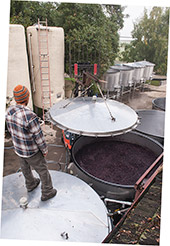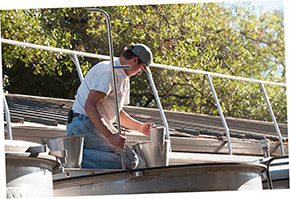Grenache (
Garnacha) most likely originated in Spain and the strength of the Aragon Kingdom accounts for the wide dispersal of the grape around the western Mediterranean. The earliest mention of Garnacha is about 1513 under the name
Aragones, designated as a black-berried variety from Madrid. In 2006, Italian researchers challenged that hypothesis asserting that the variety came from the island of Sardegna where it is known as
Cannonau. However, all three color variants, black, grey and white, exist in Spain but not in Sardegna.
 Ulises Garcia replaces the stainless steel tank top after punching the must down on newly crushed grapes.
Ulises Garcia replaces the stainless steel tank top after punching the must down on newly crushed grapes. ![[right]](/images/buttons/arrow_right.gif) We replace the top with a cloth mesh once the fermentation is bubbling, releasing carbon dioxide and some alcohol.
We replace the top with a cloth mesh once the fermentation is bubbling, releasing carbon dioxide and some alcohol.
 Fermentation on native yeasts generally begins several days after the grapes are crushed into these fermenters; once the native yeast have initiated the process, Taylor Mattus
Fermentation on native yeasts generally begins several days after the grapes are crushed into these fermenters; once the native yeast have initiated the process, Taylor Mattus ![[above]](/images/buttons/arrow_up.gif) adds some well-known yeast to guarantee that the fermentation finishes cleanly.
adds some well-known yeast to guarantee that the fermentation finishes cleanly.
More recent genetic studies indicate significant clonal diversity of Garnacha in Spain, but not in Sardegna. Grenache produces fruity red wines but it is typically blended with grape varieties with more color and tannin. As is the custom in Châteauneuf-du-Pape, we blended in sixteen percent
Dark Horse Syrah; boldly chewy with hints of sandalwood, cloves, black olives and cassis.
Gold Medal winner.

